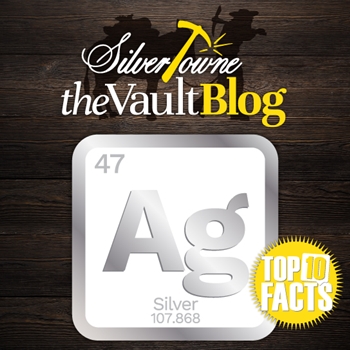
Ag stands for silver on the periodic table of elements. We here at SilverTowne are a business built on high-quality silver coins, medallions, and bars. Therefore, it makes sense that we want you to know a few things about the precious metal. We buy it, we sell it, and we know its importance in today’s market. It is versatile and has the ability to change in value over time, making it one of the most affordable and commonly collected precious metals out there.
Let us explore and explain some of the biggest things to know about silver from our point of view---one that has been in business since 1949.
1. Silver has been around for hundreds of years.
It is believed that silver, along with other metals like gold and copper, has been around since ancient civilizations. It was used in some of the first forms of currency. The mining of the precious metal was thought to have started in Asian countries like India, China, and Japan as early civilizations extracted the metal from galena, which is a primary ore of lead. Even during the Middle Ages, silver mines across Europe were being extracted from until they were thought to be exhausted by the time the Industrial Revolution (1760-1840) rolled around.
By the 19th century, silver was produced mainly in North America with key areas located in Canada, Mexico, and the United States (Nevada). Today, silver production is evenly distributed throughout the world.
2. It is cheaper than gold.
While gold, platinum, and palladium are also options to invest in when it comes to precious metals, silver is the most affordable and readily available, making it one of the most highly collected metals in today’s market. All of these metals are directly determined by the financial stock market which changes every second of every day according to the current social, political, and economic climate throughout the world.
3. Silver is great for investment purposes.
When looking to diversify your funds while maintaining a healthy investment portfolio, silver can be a great way to ensure your investment in a different way. Building and preserving wealth can be difficult and risky, but the reward for doing so can mean a greater return on investment. Diversifying your funds like your 401(k), savings accounts, mutual funds, and self-directed IRAs of precious metals can be a great way to make sure you do not put all your eggs in one basket so to speak.
4. There are a number of differences in silver fineness.
Silver is a soft and malleable, or easily adaptable, metal that general use requires other metals (most generally copper) to be mixed with it. There are a number of different alloys, so it is important to know the difference represented by work marks and numerical marks found on the silver item in question. The numerical marks are out of 1000 when depicting the number of parts of pure silver contained. Below is a simple chart to help identify the silver fineness:
- .999 - Fine/Pure Silver - 99.9% composition with slight traces of impurities - most generally used to make bullion bars and rounds for silver investments and trading - too soft for general use
- .950 - 1st French Standard - 95% silver and 5% copper or other metals
- .925 - Sterling Silver - 92.5% silver and 7.5% copper or other metals - generally found with plates, silverware, etc.
- .900 - Coin Silver - 90% silver and 10% copper or other metals - made from melting down silver coins - a number of United States early coinage denominations are comprised of 90% silver, including but not limited to Walking Liberty half dollars, Mercury dimes, Morgan silver dollars, etc.
There are a number of silver fineness percentages between and below the mentioned above, but they are not as widely known.
5. Owning 90% silver coinage is a great way to own physical silver too.
Under the Coinage Act of 1792, the United States mint made gold and silver both legal tender and authorized the production of six different silver coins. The years following, the Mint continued to make silver coins in standard currency until the Coinage Act of 1965 was passed which reduced silver content from 90% to 40%. The most recognizable 90% silver coins include but are not limited to Roosevelt dimes, Washington quarters, Walking Liberty half dollars, the Barber coinage series, and Kennedy half dollars.
Other than bullion bars and medallions, 90% silver coinage is an excellent way to collect silver. Historically speaking, United States coinage speaks for itself as the rich history of coins alone allows for the collectibility to be that much greater. In some cases, when and if push comes to shove, it’s much easier to pay for a loaf of bread or a gallon of milk with coins than it is with bullion. People also find it more feasible because of its size. While an American Silver Eagle is $1 FV, it would be much easier to pay for something with quarters or dimes. Also, when dealing with Face Value, $1,000 FV is reportable to the government when selling it to a buyer.
6. Numismatic value and precious metal value are not the same things.
Coin values depend on a number of factors, including metal content, condition, dates, mintmarks, mintages, and more. Resources within the numismatic community to help figure out those values include The Official Red Book as well as NGC and PCGS price guides.
Precious metal values are based solely on the market value which changes every second.
7. States now have sales tax requirements.
As of June 21, 2018, the Supreme Court of the United States ruled in favor of the state in South Dakota v. Wayfair, Inc. What does that mean? The decision allows states to tax remote sales. Previously, states could only tax sales by businesses with a physical presence in the state. Now economic activity in a state can trigger a sales tax collection obligation. Economic nexus is based on sales revenue, transaction volume, or a combination of both.
SilverTowne is now required to register with several other states and collect and remit to those states as an online and over the phone retailer that ships to other states. To learn more about tax requirements, SilverTowne has an interactive map and detailed state-by-state list that outlines tax requirements on our website.
8. Government-issued bullion premiums are different than SilverTowne (or other non-government bullion producers) premiums.
The United States Mint, for example, produces 1 Troy Ounce American Silver Eagles. While SilverTowne also produces 1 Troy Ounce bullion bars and medallions, the American Silver Eagle will also cost more based on a higher premium. Why? They are United States government-issued, backed, legal tender, and shipped by the Mint. The Mint will then sell those bullion edition Silver Eagles to authorized dealers across the country, which in turn causes dealers to raise their silver bullion prices for their customers. But remember, the face value of the American Silver Eagle will always remain at $1.
When it comes to SilverTowne produced bullion bars and medallions, we determine our precious metal pricing on the competitive market. We produce our own unique bullion at our own SilverTowne Mint which is backed by a guarantee of weight and purity. The market, in conjunction with spot pricing (right now price based on supply and demand), is what determines the price you pay when purchasing from our wide range of one-ounce .999 fine silver bullion options. We design, produce, and sell bullion directly to dealers and consumers which allows our top-down approach to thrive and give our customers the full and absolute benefits of owning silver for the best prices.
9. Silver can be found in many electronic and electrical products.
Many people do not know that silver is a great conductor for electricity. More than likely, everyone owns something electronic or electrical that contains silver. Circuit boards, television screens, computers, telephones, and more contain silver which has proved to be highly reliable and resourceful. Once again, silver is a soft and easily manipulative precious metal.
10. Some forms of silver are used due to their antibacterial properties.
Companies like Norwex USA have used an antibacterial silver agent in their technology-savvy cleaning products. The silver agent, which is found in their microfiber cleaning towel, is said to nix odor, mold, and mildew growth from surfaces.
Studies have also shown that the presence of silver can increase the effect of antibiotics on bacteria.
Sources: www.norwex.com; www.britannica.com







